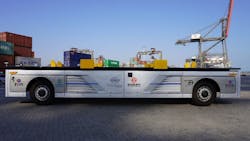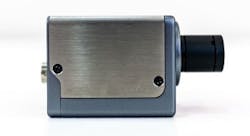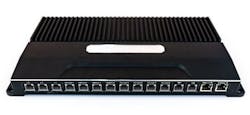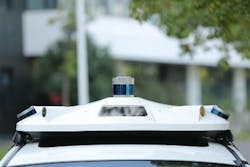What emerging trends in the autonomous-vehicle industry are shaping the future of transportation?
Robo-taxis are one trend that will change the way people get around in the future. One day people will be able to hail a fully autonomous car to take them to different locations. This is already being tested out by companies like Dongfeng Motor, which is using DeepRoute’s Level 4 self-driving solutions to test out safe and efficient robo-taxi services in China.
In addition, we’ll see more autonomous vehicles used in industrial environments to help companies cost-efficiently transport materials. For example, the Xiamen Ocean Gate Container Terminal of Cosco Shipping in China is testing out autonomous container trucks with DeepRoute’s self-driving solutions to automate operations (Fig. 1).
Finally, vehicle-to-vehicle (V2V) and vehicle-to-everything (V2X) communications will also reshape transportation as we know it. Having vehicles be able to communicate with other cars and objects (like traffic lights and toll booths) will help to dramatically reduce the rate of accidents and cut down on traffic congestion.
What are the keys to success when implementing self-driving solutions?
It’s important to consider the specific requirements for different self-driving use cases, and carefully listen to clients’ needs for their desired implementations. Self-driving robo-taxis need to be configured to communicate with passengers and maximize their comfort, while self-driving freight trucks need to be configured much differently to maximize operational efficiency.
To meet the growing demand for autonomous solutions, DeepRoute developed a full-stack Level 4 self-driving system, which includes sensing, HD mapping, perception, planning and control, simulation, and cloud technology all in one package. We designed the system to provide a safe and reliable self-driving experience with built-in flexibility so it can be customized for a broad range of implementations and use cases.
What are the top priorities when developing self-driving systems?
Safety is absolutely the number one priority when developing self-driving systems. That’s why it’s so critical to rigorously test self-driving vehicles in a wide variety of environments (highways, urban areas, winding roads, etc.), weather conditions, lighting conditions, and driving scenarios. The KITTI Vision Benchmark Suite is one way to put self-driving technologies to the test and better understand how different solutions fare when identifying different types of objects.
DeepRoute’s Hybrid Voxel Network (HVNet), a novel one-stage unified network for point cloud-based 3D object detection for autonomous driving, ranked first for cyclist detection and sixth for car detection in KITTI’s benchmarking for birds-eye detection. Additionally, in June 2020 our HVNet technology ranked first in SemanticKITTI’s benchmarking, which is based on the KITTI suite. With HVNet, the self-driving system identifies objects with extreme accurately, enabling cars to intelligently react to their surroundings, which might mean stopping for a cyclist crossing the road or slightly swerving to avoid an accident.
In addition, it’s important to consider how efficient self-driving solutions are to make them more viable for mass adoption. DeepRoute created its own inference engine instead of relying on existing solutions to create a highly efficient, low-power, and reasonably priced self-driving system. (Click here to view the CVPR 2020 paper submission.)
Can you share more details around DeepRoute’s L4 full-stack self-driving system?
The Level 4 full-stack self-driving system is a fully integrated solution made of all the essential components needed for a seamless autonomous driving experience:
The system covers every part of self-driving technology using sensing, perception, HD mapping, a real-time positioning system, and a planning and control system.
To better utilize HVNet, DeepRoute developed its own inference engine, called DeepRoute-Engine. DeepRoute-Engine optimizes the computational resources for HVNet’s custom operator and network structure to efficiently run on a low-cost and low-power consumption hardware platform that’s also very reliable.
DeepRoute-Vision (Fig. 2) and its synchronization controller for sensor data, DeepRoute-Syntric (Fig. 3), can accurately detect surrounding objects in real-time to deliver a safe and smooth driving experience.
We designed our camera, called DeepRoute-Vision, to avoid overexposure—even under strong sunlight—using automatic image adjustment and fine LED flicker resistance:
Our customers have the option to implement the full-stack solution or individual modules, which include:
- Multiple sensor options
- High-definition HD mapping and localization
- Premium perception
- Planning and control models for a smooth drive at speeds of 80 km/h or more
- Simulation system that can be tested virtually, which is especially valuable for corner cases
- Cloud technology to improve the efficiency of software development
We also have our DeepRoute-Sense solution (Fig. 4). This slim vehicle roof box is equipped with eight vehicle cameras, three LiDARs, GNSS, and other sensors, along with corresponding telecommunication and data-synchronization controllers.
What types of features and functions set this solution apart from competitors?
DeepRoute has a top-rated perception algorithm, which ranked highly on the KITTI and SemanticKITTI tests and even was recognized as a CES Innovation Awards honoree. Our highly integrated solutions make it easier for companies to develop and roll out their own self-driving vehicles and implementations, while also allowing for customers to customize our solutions for their specific needs and use cases.
DeepRoute’s computing platform, DeepRoute-Tite, is extremely efficient and consumes about 1/9 the power of traditional solutions:
Also, our system is half the cost of traditional solutions and is 1/170 the size. With this small computing platform, we have been able to significantly reduce system cost, size, and power consumption while still powering Level 4 autonomous driving capabilities, including perception, prediction, decision-making, planning and control, and navigation.
What are some of the key product challenges DeepRoute has overcome?
The key product challenge DeepRoute has faced is testing our system in different scenarios. There have been instances when the model was initially not able to identify an object that’s not typically found on urban roadways. By implementing an advanced deep-learning perception model, we were able to train the model to learn and recognize objects more quickly.
For example, shipping containers and cranes are very unusual objects. When these objects were introduced to our perception model in tests, autonomous container trucks powered by our technology learned how to identify those objects to avoid them as they navigate.
Nianqiu Liu is Vice President and tech lead of the hardware team at DeepRoute.ai. He is well-versed in intelligent hardware, IoT, intelligent manufacturing and in-vehicle electronics. Nianqiu is a former Intel senior engineer and an experienced serial entrepreneur.
About the Author
William G. Wong
Senior Content Director - Electronic Design and Microwaves & RF
I am Editor of Electronic Design focusing on embedded, software, and systems. As Senior Content Director, I also manage Microwaves & RF and I work with a great team of editors to provide engineers, programmers, developers and technical managers with interesting and useful articles and videos on a regular basis. Check out our free newsletters to see the latest content.
You can send press releases for new products for possible coverage on the website. I am also interested in receiving contributed articles for publishing on our website. Use our template and send to me along with a signed release form.
Check out my blog, AltEmbedded on Electronic Design, as well as his latest articles on this site that are listed below.
You can visit my social media via these links:
- AltEmbedded on Electronic Design
- Bill Wong on Facebook
- @AltEmbedded on Twitter
- Bill Wong on LinkedIn
I earned a Bachelor of Electrical Engineering at the Georgia Institute of Technology and a Masters in Computer Science from Rutgers University. I still do a bit of programming using everything from C and C++ to Rust and Ada/SPARK. I do a bit of PHP programming for Drupal websites. I have posted a few Drupal modules.
I still get a hand on software and electronic hardware. Some of this can be found on our Kit Close-Up video series. You can also see me on many of our TechXchange Talk videos. I am interested in a range of projects from robotics to artificial intelligence.






